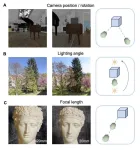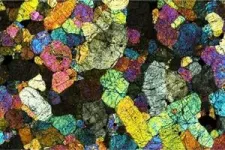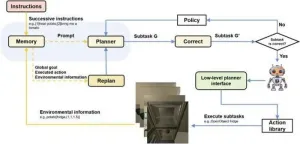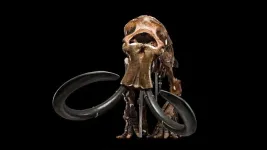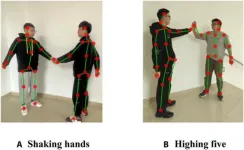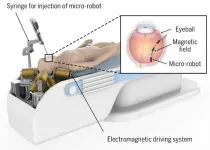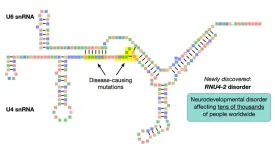(Press-News.org) UNIVERSITY PARK, Pa. — A novel, human-inspired approach to training artificial intelligence (AI) systems to identify objects and navigate their surroundings could set the stage for the development of more advanced AI systems to explore extreme environments or distant worlds, according to research from an interdisciplinary team at Penn State.
In the first two years of life, children experience a somewhat narrow set of objects and faces, but with many different viewpoints and under varying lighting conditions. Inspired by this developmental insight, the researchers introduced a new machine learning approach that uses information about spatial position to train AI visual systems more efficiently. They found that AI models trained on the new method outperformed base models by up to 14.99%. They reported their findings in the May issue of the journal Patterns.
“Current approaches in AI use massive sets of randomly shuffled photographs from the internet for training. In contrast, our strategy is informed by developmental psychology, which studies how children perceive the world,” said Lizhen Zhu, the lead author and doctoral candidate in the College of Information Sciences and Technology at Penn State.
The researchers developed a new contrastive learning algorithm, which is a type of self-supervised learning method in which an AI system learns to detect visual patterns to identify when two images are derivations of the same base image, resulting in a positive pair. These algorithms, however, often treat images of the same object taken from different perspectives as separate entities rather than as positive pairs. Taking into account environmental data, including location, allows the AI system to overcome these challenges and detect positive pairs regardless of changes in camera position or rotation, lighting angle or condition and focal length, or zoom, according to the researchers.
“We hypothesize that infants' visual learning depends on location perception. In order to generate an egocentric dataset with spatiotemporal information, we set up virtual environments in the ThreeDWorld platform, which is a high-fidelity, interactive, 3D physical simulation environment. This allowed us to manipulate and measure the location of viewing cameras as if a child was walking through a house,” Zhu added.
The scientists created three simulation environments — House14K, House100K and Apartment14K, with ‘14K’ and ‘100K’ referring to the approximate number of sample images taken in each environment. Then they ran base contrastive learning models and models with the new algorithm through the simulations three times to see how well each classified images. The team found that models trained on their algorithm outperformed the base models on a variety of tasks. For example, on a task of recognizing the room in the virtual apartment, the augmented model performed on average at 99.35%, a 14.99% improvement over the base model. These new datasets are available for other scientists to use in training through www.child-view.com.
“It's always hard for models to learn in a new environment with a small amount of data. Our work represents one of the first attempts at more energy-efficient and flexible AI training using visual content,” said James Wang, distinguished professor of information sciences and technology and advisor of Zhu.
The research has implications for the future development of advanced AI systems meant to navigate and learn from new environments, according to the scientists.
“This approach would be particularly beneficial in situations where a team of autonomous robots with limited resources needs to learn how to navigate in a completely unfamiliar environment,” Wang said. “To pave the way for future applications, we plan to refine our model to better leverage spatial information and incorporate more diverse environments.”
Collaborators from Penn State’s Department of Psychology and Department of Computer Science and Engineering also contributed to this study. This work was supported by the U.S. National Science Foundation, as well as the Institute for Computational and Data Sciences at Penn State.
END
Children’s visual experience may hold key to better computer vision training
2024-05-31
ELSE PRESS RELEASES FROM THIS DATE:
2024 Mahoney Life Sciences Prize goes to food scientist Lynne McLandsborough
2024-05-31
University of Massachusetts Amherst food scientist Lynne McLandsborough has won the 2024 Mahoney Life Sciences Prize for her research that offers a solution to a sticky sanitation and food safety dilemma hounding the peanut butter and chocolate industries.
“I was really surprised and excited,” McLandsborough says of winning the prize. “I think our research is innovative and there’s a need in the industry. It was a fun project.”
She is already in talks with Mars, the world’s ...
Ancient medicine blends with modern-day research in new tissue regeneration method
2024-05-31
For centuries, civilizations have used naturally occurring, inorganic materials for their perceived healing properties. Egyptians thought green copper ore helped eye inflammation, the Chinese used cinnabar for heartburn, and Native Americans used clay to reduce soreness and inflammation.
Flash forward to today, and researchers at Texas A&M University are still discovering ways that inorganic materials can be used for healing.
In two recently published articles, Dr. Akhilesh Gaharwar, a Tim and Amy Leach Endowed Professor in the Department of Biomedical Engineering, and Dr. Irtisha Singh, assistant professor in the Department of Cell Biology ...
Navigating new horizons: Pioneering AI framework enhances robot efficiency and planning
2024-05-31
In a groundbreaking study published in Cyborg Bionic Systems, researchers from Shanghai University have unveiled a new artificial intelligence framework that revolutionizes the way robots interpret and execute tasks. The "Correction and Planning with Memory Integration" (CPMI) framework leverages large language models (LLMs) to improve the efficiency and effectiveness of robots performing complex, instruction-based tasks.
Traditionally, robots required explicit programming and extensive data to navigate ...
Tirzepatide for weight reduction in Chinese adults with obesity
2024-05-31
About The Study: In Chinese adults with obesity or overweight, once-weekly injection with tirzepatide 10 mg or 15 mg resulted in statistically significant and clinically meaningful weight reduction with an acceptable safety profile.
Corresponding Author: To contact the corresponding author, Xiaoying Li, M.D., email li.xiaoying@zshospital.sh.cn.
To access the embargoed study: Visit our For The Media website at this link https://media.jamanetwork.com/
(doi:10.1001/jama.2024.9217)
Editor’s Note: Please see the article for additional information, including other authors, author contributions and affiliations, conflict of interest and financial ...
U of T researchers discover ‘trojan horse’ virus hiding in human parasite
2024-05-31
An international team led by researchers at the University of Toronto has found a new RNA virus that they believe is hitching a ride with a common human parasite.
The virus, called Apocryptovirus odysseus, along with 18 others that are closely related to it, was discovered through a computational screen of human neuron data – an effort aimed at elucidating the connection between RNA viruses and neuroinflammatory disease. The virus is associated with severe inflammation in humans infected with the ...
Clues to mysterious disappearance of North America’s large mammals 50,000 years ago found within ancient bone collagen
2024-05-31
50,000 years ago, North America was ruled by megafauna. Lumbering mammoths roamed the tundra, while forests were home to towering mastodons, fierce saber-toothed tigers and enormous wolves. Bison and extraordinarily tall camels moved in herds across the continent, while giant beavers plied its lakes and ponds. Immense ground sloths weighing over 1,000 kg were found across many regions east of the Rocky Mountains.
And then, sometime at the end of the Last Ice Age, most of North America’s megafauna disappeared. How and why remains hotly contested. Some researchers believe the arrival of humans was pivotal. Maybe the animals were hunted and eaten, or maybe humans just altered ...
Revolutionizing interaction recognition: The power of merge-and-split graph convolutional networks
2024-05-31
In a significant advancement for robotics and artificial intelligence, researchers at Chongqing University of Technology, along with their international collaborators, have developed a cutting-edge method for enhancing interaction recognition. The study, published in Cyborg and Bionic Systems, introduces the Merge-and-Split Graph Convolutional Network (MS-GCN), a novel approach specifically designed to address the complexities of skeleton-based interaction recognition.
Human interaction recognition plays a crucial role in various applications, ranging from enhancing human-computer interfaces ...
Do shape-memory alloys remember past strains in their life?
2024-05-31
Endowed with the power of memory, certain alloys can magically return to their original shape when heated or deformed. However, the repeated back-and-forth between the original and new configuration may leave permanent imprints on the alloy’s microscopic features, which could then impact its ability to reversibly transform shape. Thus, unraveling the impact of the strain history on these alloys’ functionality is essential to improving predictive capabilities, but it has not received enough attention.
To fill this knowledge gap, the National Science Foundation ...
A novel electromagnetic driving system for 5-DOF manipulation in intraocular microsurgery
2024-05-31
The electromagnetic driving systems are proposed for the flexible 5-DOF magnetic manipulation of a micro-robot within the posterior eye, enabling precise targeted drug delivery. A research team has presented a novel electromagnetic driving system that consists of eight optimized electromagnets arranged in an optimal configuration and employs a control framework based on an active disturbance rejection controller (ADRC) and virtual boundary.
The team published their findings in Cyborg and Bionic Systems on Mar 23, 2024.
Intraocular microsurgery has witnessed a transition from the utilization of conventional handheld surgical tools to the adoption of robot-assisted surgery, owing ...
Researchers identify a genetic cause of intellectual disability affecting tens of thousands
2024-05-31
New York, NY [May 31, 2024]—Researchers at the Icahn School of Medicine at Mount Sinai and others have identified a neurodevelopmental disorder, caused by mutations in a single gene, that affects tens of thousands of people worldwide. The work, published in the May 31 online issue of Nature Medicine [DOI: 10.1038/s41591-024-03085-5], was done in collaboration with colleagues at the University of Bristol, UK; KU Leuven, Belgium; and the NIHR BioResource, currently based at the University of Cambridge, UK.
The findings will improve clinical diagnostic ...
